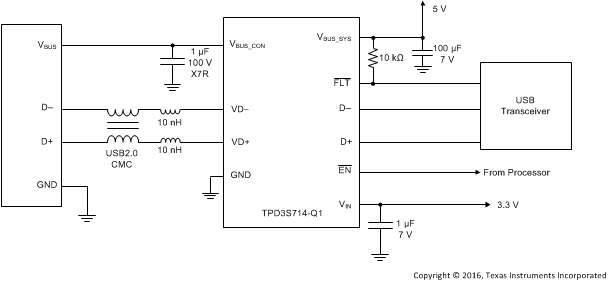SLVSCG4C January 2016 – August 2020 TPD3S714-Q1
PRODUCTION DATA
- 1 Features
- 2 Applications
- 3 Description
- 4 Revision History
- 5 Pin Configuration and Functions
- 6 Specifications
- 7 Parameter Measurement Information
-
8 Detailed Description
- 8.1 Overview
- 8.2 Functional Block Diagram
- 8.3
Feature Description
- 8.3.1 AEC-Q100 Qualified
- 8.3.2 Short-to-Battery and Short-to-Ground Protection on VBUS_CON
- 8.3.3 Short-to-Battery and Short-to-VBUS Protection on VD+, VD–
- 8.3.4 ESD Protection on VBUS_CON, VD+, VD–
- 8.3.5 Low RON nFET VBUS Switch
- 8.3.6 High Speed Data Switches
- 8.3.7 Hiccup Current Limit
- 8.3.8 Fast Overvoltage Response Time
- 8.3.9 Integrated Input Enable
- 8.3.10 Fault Output Signal
- 8.3.11 Thermal Shutdown Feature
- 8.3.12 16-pin SSOP Package
- 8.4 Device Functional Modes
- 9 Application and Implementation
- 10Power Supply Recommendations
- 11Layout
- 12Device and Documentation Support
- 13Mechanical, Packaging, and Orderable Information
Package Options
Mechanical Data (Package|Pins)
- DBQ|16
Thermal pad, mechanical data (Package|Pins)
Orderable Information
3 Description
The TPD3S714-Q1 is a single-chip solution for short-to-battery, short-circuit, and ESD protection for the USB connector’s VBUS and data lines in automotive USB hubs, head units, rear seat entertainment, telematics, and media interface applications. The integrated data switches provide best-in-class bandwidth for minimal signal degradation during USB short-to-battery events. The high bandwidth of 1 GHz allows for a clean USB 2.0 high-speed (480 Mbps) eye diagram with the long captive cables that are common in the automotive USB environment
The short-to-battery protection isolates the internal system circuits from any overvoltage conditions at the VBUS_CON, VD+, and VD– pins. On these pins, the TPD3S714-Q1 can handle overvoltages up to 18 V for hot plug and DC events. The overvoltage protection circuit provides the most reliable short-to-battery isolation in the industry, shutting off the switches and protecting the upstream transceiver from harmful voltage and current spikes. The VBUS_CON pin also provides an accurate current limited load switch up to 0.5 A. The overcurrent protection automatically limits current to prevent drooping of the upstream rail during short-to-ground events. Additionally, this device also integrates system level IEC 61000-4-2 and ISO 10605 ESD protection on VBUS_CON, VD+, and VD– pins which removes the need to provide external high-voltage, low capacitance ESD diodes
| PART NUMBER | PACKAGE | BODY SIZE (NOM) |
|---|---|---|
| TPD3S714-Q1 | SSOP (16) | 4.90 mm × 3.90 mm |
 Typical Application Schematic
Typical Application Schematic